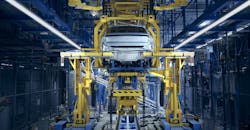The automotive industry is undergoing a transformative shift toward sustainability, driven by the urgent need to address climate change. With the United Nations Climate Change Conference (COP28) underway, now is to take a closer look at how the automotive supply chain is ramping up efforts to reduce greenhouse emissions (GHGs).
Central to the industry’s evolution is the decarbonization of the entire automotive value chain, with a particular focus on Scope 3 emissions. Scope 3 emissions represent a significant share of a company’s overall carbon footprint, extending beyond direct operational activities (Scope 1) and indirect energy consumption (Scope 2). Scope 3 emissions encompass indirect emissions generated across the entire value chain, including the production of materials like steel, plastics, aluminum, batteries and glass.
Ford’s new Cologne, Germany, EV plant is an example of an emissions-reductions strategy across the value chain.
- Scope 1: Ford will reduce the use of energy and emissions at the Cologne plant by installing new processes, machinery and technologies. All electricity and natural gas required to operate the facility are carbon-neutral, based on being 100% certified renewable electricity and biomethane.
- Scope 2: By 2026, the local energy provider plans to have reduced its operating emissions for heat delivery by approximately 60%.
- Scope 3: The company is taking steps to secure raw materials directly from mining companies.
Understanding the dynamics of affordable (and available) clean and renewable energy is crucial to developing an emissions-free supply chain. There are, however, significant challenges in deploying the low-carbon energy resources crucial to decarbonizing automotive supply chains.
In Europe, these challenges were summarized in a joint letter to EU heads of state from leaders of clean technology industries and key materials suppliers. It calls for prompt action in a range of areas, including:
- Fast-tracking permitting: Numerous solar, strategic raw materials and wind projects are reportedly stuck in bureaucratic limbo. The installation of new and/or upgraded infrastructure for electricity, hydrogen and CO2 is an absolute priority. The letter urges accelerated adoption of new permitting rules in all cleantech sectors, including materials extraction, processing and recycling.
- Developing appropriate market incentives: Incentives for procuring local materials and components will help address cost differentials and level the playing field for sustainable production practices, while avoiding disruptions in global supplies.
Many challenges related to value-chain decarbonization are addressed at the C-suite level. However, material engineers, procurement department leaders, quality managers and supplier management leaders must also deal with these strategies. They must have detailed knowledge about the impact of component materials on carbon footprints. We are not talking about emissions related solely to logistics, but about the carbon footprint of the production process itself.
Products like steel, aluminum, electric batteries, and plastics are often referred to as “hotspots” — that is, major producers of CO2 emissions and other greenhouse gases. According to a McKinsey & Company study, typical upstream EV emissions include the battery (40%–60%), steel (15%–20%), aluminum (10%–20%) and plastics (around 10%). Upstream internal combustion engine (ICE) vehicle emissions include steel (25%–35%), aluminum (20%–30%) and plastics (15%–20%).
These figures suggest the benefits OEMs can obtain by investing in supplier development and management strategies related to carbon footprint reduction across the value chain. According to the International Energy Agency, iron ore is the source of around 70% of metallic raw material inputs in steelmaking globally; the rest is supplied in the form of recycled steel scrap. Steel production from scrap requires only around one-eighth of the energy that producing from iron requires.
However, scrap cannot fulfill the sector’s raw material input requirements. Steel production today is higher than when the products that are now being recycled were produced. This means that recycling alone cannot be relied on to reduce emissions sufficiently to meet climate goals. Supply chain managers should seek to establish transparency across the entire value chain. They should obtain visibility on steel sources and whether these sources change over time.
Let’s examine the main carbon-emitting hotspots in automotive supply chains.
Steel: A Crucial Battleground
Traditional methods of steel production cause high emissions due to the use of fossil fuels in the smelting process. Decarbonization efforts involve adopting innovative technologies like hydrogen-based steelmaking and electric arc furnaces powered by renewable energy. Transitioning to sustainable steel production is vital to mitigating the impact of Scope 3 emissions and reducing the automotive industry's overall carbon footprint.
According to GM’s 2022 Sustainability Report, U.S. Steel has agreed to provide GM with steel that has up to 75% fewer emissions than traditional blast furnace steel. If prices are no more than 20% higher than commercial prices (or if GM leadership backs an exception), at least 10% of the crude steel used to manufacture the sheet steel that GM directly purchases for its U.S., Canada and Mexico manufacturing facilities is slated to be near-zero emission in 2030.
Volkswagen Group is also working with steel manufacturers to advance the transition to emission-reduced steel products. The Volkswagen subsidiary Scania has entered into a cooperation agreement with the H2 Green Steel start-up. Volkswagen has also signed a memorandum of understanding with Salzgitter AG to be one of the first customers of Salzgitter’s low-CO2 steel. By the end of 2025, the steel will be produced on a new production line at Salzgitter’s headquarters in the German state of Lower Saxony.
Plastics: Unveiling the Environmental Costs
Plastics, widely used in automotive components, pose an environmental and sustainability challenge. The production of plastics, particularly from petrochemical sources, contributes significantly to carbon emissions. Addressing this hotspot involves embracing circular economy principles, recycling plastics and developing bio-based alternatives. Recycling initiatives and reducing dependence on fossil fuels for plastic production will enable the automotive industry to make substantial strides in Scope 3 emissions reduction.
BASF has become a leader in the effort to reduce CO2 emissions in plastics production processes. With its partners, it has developed pyrolysis technology, which turns plastic waste into a secondary raw material called pyrolysis oil. The oil is used at the beginning of the value chain at BASF’s Verbund (Austria) production sites, thus reducing the use of fossil fuels.
Pyrolysis of mixed plastic waste emits 50% less CO2 than incinerating mixed plastic waste. The ability to convert consumer waste into safe, quality parts for premium products through BASF’s ChemCycling process is an important step in advancing a zero-waste future.
BASF and Green & Light Automotive Components also jointly developed a trunk floor made with recycled polyurethane (PU) waste generated during the parts manufacturing process.
Aluminum: Shaping Lightweight Sustainability
Traditional aluminum production is energy-intensive and contributes to significant carbon emissions. The adoption of recycled aluminum, coupled with advancements in low-carbon primary aluminum production, is essential to mitigate environmental impacts. Innovations in aluminum production processes (e.g., smelting using renewable energy sources) offer promising avenues for reducing Scope 3 emissions.
According to GM, if low-carbon prices are no more than 20% higher than commercial prices (or if GM leadership backs an exception), at least 10% of primary aluminum used to manufacture sheet aluminum for GM’s U.S., Canada, and Mexico manufacturing facilities will be low-carbon in 2030.
Batteries: Powering a Sustainable Future
The rise of EVs has highlighted the environmental impact of battery production. Manufacturing lithium-ion batteries involves resource-intensive processes that contribute to Scope 3 emissions. EV batteries contain nickel, manganese, cobalt, lithium and graphite, which emit substantial amounts of GHGs during the mining and refining processes.
Some processes in the production of anode and cathode active materials require high, energy-intensive temperatures. Other factors that determine the amount of embedded production carbon include battery chemistry, production technology, raw material suppliers and transportation routes.
To address this, R&D efforts are directed toward improving battery technology, enhancing energy density and exploring alternative materials. Recycling programs for end-of-life batteries are essential to close the loop and minimize environmental impact.
Auto OEMs continue to acquire information about the operations of their suppliers to improve the setting of benchmarks in the production, quality, performance, costs and ecology of battery cells.
BMW is laying the technological foundation for efficient, resource-saving battery-cell production along the entire value chain. Sample production of sixth-generation round cells has already begun. These cells have up to 20% higher energy density, and BMW reports it has been able to reduce the CO2 footprint in cell production by up to 60%.
BMW’s “local-for-local” principle also ensures that the next step — high-voltage battery assembly — takes place as close as possible to vehicle plants.
The decarbonization of the automotive value chain is a multifaceted challenge that requires a comprehensive approach across the entire value chain, from raw material suppliers to manufacturers and consumers. Governments also have a central role to play.
The average EV reportedly has around 15,000 parts; ICE vehicles have closer to 30,000. This suggests that EVs have less complexity.
However, the entire value chain of electric batteries — from the mining of materials to the end of life — requires collaboration beyond established supplier–customer relationships.
Jan Burian is senior director, head of IDC Manufacturing Insights EMEA and leader of Europe: Future of Operations Practice.
About the Author

Jan Burian
Global Analyst
Jan Burian is a global analyst, author, and speaker. His expertise spans digital transformation, management, leadership, and the geopolitical influences shaping manufacturing and global supply chains. Jan led Manufacturing Insights Europe at IDC and held consulting positions at EY and Deloitte.
